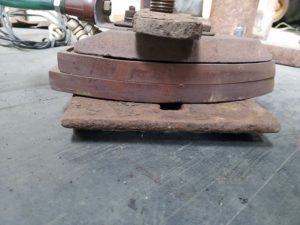
Although it is the 21st century with its “high” technologies, many processes remain unchanged. Especially in the workshops of home craftsmen.
For example, rubber vulcanization... In factory devices, the principle is the same, but the process control is entrusted to electronics.
I bring to your attention the design of a homemade vulcanizer. Although the process has to be controlled independently, the device is as simple as 3 kopecks ...
As a heating element, a heating element of an old but efficient iron was used.
The stand, as you may have noticed, is too big for a vulcanizer.
The fact is that this rack with a screw is multifunctional and is used in several other homemade products: a press, a bearing puller, a massive clamp, etc. and so on.
In subsequent articles, perhaps I will show its other functions. Today it is a vulcanizer!
The design of this homemade vulcanizer used 2 irons.
One - with a working heater, and from the second - only the "sole". Instead of the lower iron, you can use a sheet of metal with a thickness of 3mm or more.
The principle of operation of this vulcanizer when repairing a car chamber is as follows:
- The puncture site on the camera is determined.
- The space around the puncture on the chamber is degreased with gasoline.
- Cut out a patch of raw rubber
- The patch is placed in a container with gasoline for 10 minutes (do not forget to remove the film from one side of the raw rubber).
- After 10 minutes, the vulcanizer is assembled:
- A newspaper is placed on the bottom "sole".
- On top of the newspaper - a camera puncture up.
- A wet rubber patch soaked in gasoline is placed on the fat-free place of the chamber.
- If the puncture is minor, you can simply lay a newspaper on top of the raw rubber
- If the “hole” is large, you should additionally put a patch of ordinary rubber on top of the raw rubber patch, and on top of it all the same newspaper.
- All this is covered with a heating element of an iron.
- With the help of a press, this whole sandwich is pulled together.
Now turn on the top iron. The temperature of the heating element must be brought to 180 degrees.
In this design, the temperature is controlled using a mercury thermometer with a measurement limit of 200 degrees Celsius.
As soon as the temperature has reached the desired value (literally in 1 minute), the iron must be turned off and the vulcanizer left for 15-20 minutes until it cools completely. Cooling should occur naturally.
When everything has cooled down, you can disassemble the “sandwich” and mount the camera.
As an example, here are two patches made by this vulcanizer: